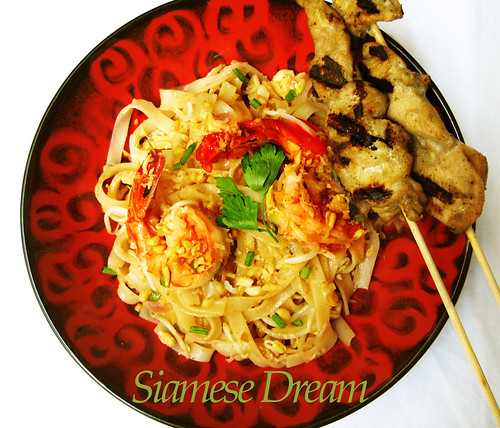Pad Thai

Just yesterday it was my mom's birthday, so I prepared 5 courses and dessert. My neck still hasn't recovered from a whole day of looking down on what I was chopping, but it was worth it to try out some new dishes. I realize that it's risky business to try out untested food on guests, but I wasn't about to do all repeat performances; I'm not yet that boring. Now, one of the Chinese traditions that somehow rubbed off to Filipino society is the serving of noodles at a birthday for long life. I don't like superstition but I do love noodles, so why not. And just to give myself a break from making one Italian pasta dish after another, I made Pad Thai. Complex with the flavors of peanuts, sugar, fish sauce, and a lot of unidentifiable substances to those unfamiliar with Thai cooking traditions (me included), it's one of our favorite Thai dishes.
The problem with the recipe I got was that it called for tamarind paste (a very dark-colored substance), which try as I might, I couldn't find. Instead I used Mama Sita's "Biglang Sinigang" ("Suddenly Sour soup") paste made with tamarind, which looked like pale baby food, but less palatable. But even with bananas in the ingredients, it had to taste like tamarind. It costs only P30 (30p or 66¢), but it doesn't sell well (compared to instant sinigang powder mix), so I'll have to improvise some more when it goes away. The recipe I got is from mamster of the eGullet forums again, with some ingredients adjusted to my taste and to give it a darker color. (Recipe follows)
Note on the picture: those are sticks of chicken satay which I prepared on the side. I'll share a recipe once I get it perfectly. Also, those of you who read Graeme's blog (and you really should) might recognize the bowl. I loved the pattern so much I bought two.
Pad Thai
Dissolve the 1/4 cup of salt in 2 cups of cold water. Soak the shrimp in this solution for 30 minutes in the fridge.
In the meantime, soak the rice stick noodles in hot water (60°C or 140°F) for 20 minutes.
In a small bowl, pour boiling water over the tamarind paste. Let sit for 2 minutes, stir well, then strain into another bowl, discarding the undissolved solids. To the tamarind water, add the fish sauce, soy sauce, vinegar, sugar, cayenne pepper, and 2 tablespoons of the oil. Set aside.
Drain and pat the shrimp dry between thicknesses of paper towels. Drain the rice noodles and set aside. Heat 1 tablespoon of the oil in a large skillet over smoking-hot heat for 2 minutes, then add the shrimp. Stir-fry for 2 minutes. Remove the shrimp from the oil and set aside. Add the last bit of oil into the pan and reduce the heat to medium. Stir-fry the garlic and shallots for 1-1/2 minutes. Add the egg and scramble for 20 seconds. Add the noodles and bean sprouts and toss to combine with the eggs well. Add the sauce and increase the heat to high. Toss well until the noodles are thoroughly coated. Add the peanuts, all but half a tablespoon of the scallions, and the shrimp. Toss 2-1/2 minutes or until the noodles are tender. Transfer to the serving platter. Chop the cilantro finely and sprinkle on top with the remaining scallions. Serve with more chopped peanuts, sugar, and chili powder on the side.















































